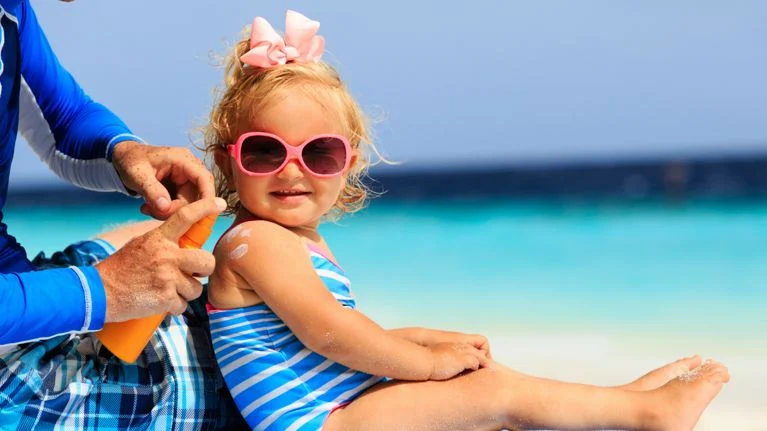With all the sunscreens available these days, choosing the right one for your kids can be tricky. But what matters most when using sunscreen is how well it protects the skin from harmful UV rays. In this guide, we will cover everything you need to know about choosing and using sunscreen effectively.
What Kind of Sunscreen Is Best?
When buying sunscreen, there are three important things to look for. Check the label for a sunscreen that:
- Has an SPF (sun protection factor) of 30 or higher
- Protects against both UVA and UVB rays (a “broad-spectrum” sunscreen)
- Is water-resistant (protects kids while in the water for 40-80 minutes)

What Are the Different Types of Sunscreen?
There are two broad categories of sunscreen:
- Mineral sunscreen (also called inorganic or physical sunscreen) sits on top of the skin and acts as a barrier to the sun’s rays. It contains zinc oxide or titanium dioxide, which may leave a whitish coating on the skin. Mineral sunscreen starts working as soon as it is applied but can come off easily with water or sweat.
- Chemical sunscreen (also called organic sunscreen) protects the skin by absorbing the sun’s rays like a sponge. It converts the rays into heat and then releases that heat from the skin. Chemical sunscreens do not leave a whitish coating on the skin and are less likely to come off with water or sweat. However, they may take 15-30 minutes to start working.
Sunscreens are available in various forms such as creams, gels, sprays, and sticks. Creams are best for dry skin areas, sticks are useful around the eye area, and gels are suitable for areas with hair, like the scalp. Sunscreen sprays can make it hard to determine if you’ve applied enough, and there’s a chance that kids could breathe in the fumes. Some sprays are also flammable, so caution is necessary.
How, When, and Where to Use Sunscreen
For sunscreen to do its job effectively, it must be used correctly:
- Apply sunscreen whenever your kids will be in the sun. For best results, apply it about 15 to 30 minutes before going outside.
- Don’t forget to apply sunscreen to ears, hands, feet, shoulders, and behind the neck. Lift up bathing suit straps and apply sunscreen underneath them in case the straps shift as a child moves. Protect lips with an SPF 30 lip balm.
- Apply sunscreen generously. Dermatologists recommend using 1 ounce (enough to fill a shot glass or plastic medicine cup) to cover the exposed areas of the body. Alternatively, use the “teaspoon rule.” Apply 1 teaspoon to the face and neck, 1 teaspoon to the front and back of the torso, 1 teaspoon for each arm, and 2 teaspoons for each leg.
- Reapply sunscreen often, approximately every 2 hours. Reapply after a child has been sweating or swimming.
- If kids will be around water or swimming, opt for a water-resistant sunscreen. Water reflects and intensifies the sun’s rays, so kids need protection that lasts. Water-resistant sunscreens may last up to 80 minutes in the water, and some are also sweat-resistant. Regardless of the water-resistant label, be sure to reapply sunscreen when kids come out of the water.

Don’t worry about making a bottle of sunscreen last. Stock up, and be sure to throw out any sunscreen that is past its expiration date or that you have had for three years or longer.
Who Needs Sunscreen?
Every child needs sun protection. The American Academy of Dermatology (AAD) recommends that all kids, regardless of their skin tone, wear sunscreen with an SPF of 30 or higher. Although dark skin has more protective melanin and tans more easily than it burns, tanning is a sign of sun damage. Dark-skinned kids can also get painful sunburns.
For babies younger than 6 months old, it is best to keep them out of the sun. When going outside, dress your baby in lightweight clothes that cover their arms and legs, and don’t forget a hat with a brim. If you can’t avoid the sun, use a small amount of sunscreen on your baby’s exposed skin, such as the hands and face.
Be a good role model by consistently wearing sunscreen with SPF 30 or greater and limiting your sun exposure. This will not only reduce your risk of skin damage but also teach your kids good sun sense.
What Else Should I Know?
- Avoid sunscreens with PABA, which can cause skin allergies. Also, avoid oxybenzone, an ingredient that may have hormonal properties.
- If you have sensitive skin, choose a mineral sunscreen with the active ingredients zinc oxide or titanium dioxide.
- Teens or preteens who want to use a self-tanner sunscreen should choose one that also has UV protection.
- Some cosmetics contain sunscreen, but they usually don’t offer enough protection from the sun. Make sure your teen puts sunscreen on before applying makeup.
When choosing a sunscreen, remember that the best sunscreen is the one you and your family will use every time you’re in the sun.
FAQs
Q: Can babies younger than 6 months old use sunscreen?
A: It is best to keep babies younger than 6 months old out of the sun. When going outside, dress them in lightweight clothes that cover their arms and legs, and use a hat with a brim. If you can’t avoid the sun, use a small amount of sunscreen on their exposed skin, like the hands and face.
Q: How often should sunscreen be reapplied?
A: Sunscreen should be reapplied approximately every 2 hours. Reapply after a child has been sweating or swimming.
Conclusion
Choosing and using sunscreen correctly is essential for protecting your kids’ skin from the harmful effects of the sun. Look for a sunscreen with a high SPF, broad-spectrum protection, and water resistance. Apply it generously and reapply regularly, especially after swimming or sweating. Remember that every child, regardless of skin tone, needs sun protection. Be a good role model by consistently wearing sunscreen and teaching your kids good sun sense. Stay safe and enjoy the sun responsibly!

